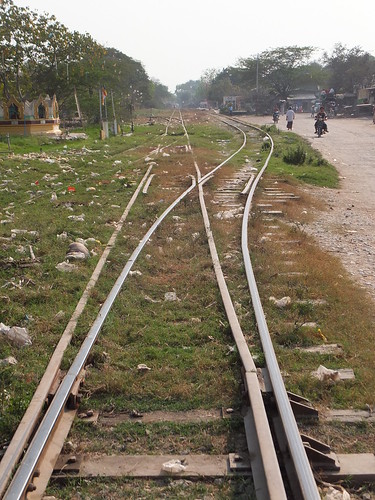skip to main |
skip to sidebar
In Part 3 of Hugh Hughes excellent guide to railway locomotives in India (introduced here), there is the following brief information about the Madaya Light Railway in Burma (now Myanmar).
The Madaya Light Railway was a 2 ft 6 in (762 mm) narrow gauge railway that terminated in Mandalay, Burma. The first section to Toungbyon, 8 miles long, opened in 1912. The railway was extended a further 8 miles to Madaya in 1917. The company operating the line went into liquidation in 1919, and the railway was taken over by the Government. The line was closed in 1927 when it was replaced by a metre gauge line
The first four locomotives for the line were obtained second hand from the Thaton – Duyinzaik Railway.
Locomotives 1 & 2 were 0-4-2 Saddle Tanks built 1882 by Barr, Morrison and Company.
Locomotive 3 was a 6-coupled well tank built 1885 by Dick Kerr and Company.
Locomotive 4 was another 6-coupled locomotive built in 1901 by Dick Kerr and Company.
Statistics for March 1921 listed seven locomotives but no information is available about the additional three locomotives.
Further details of the first four locomotives are given in the post Thaton – Duyinzaik Railway.
Myanma Railways still operate a passenger service on the metre gauge line from Mandalay to Madaya.

Owe Boe station on the metre gauge Madaya line looking towards Mandalay in 2013.
Pictures of Owe Boe station
Owe Boe Station, Mandalay.
In Part 3 of Hugh Hughes excellent guide to railway locomotives in India (introduced here), there is the following brief information about the long-gone Thaton – Duyinzaik line in Burma (now called Myanmar).
The Thaton – Duyinzaik Railway was a 2ft 6in (762 mm) narrow gauge railway opened in 1885 built and worked by Mr. George Dawson of Rangoon. From Thaton, the railway extended 8 miles east alongside a public road through jungle to Duyinzaik, connecting with a daily launch service also operated by Mr. Dawson to Moulmein.
In 1895 the inspecting officer reported:-
"Trains are not worked by any of the systems prescribed for railways. The Manager who lives at Duyinzaik controls the traffic and gives instructions directly to the drivers or by telephone to the station master at Thaton."
Locomotives 1 & 2 were built in 1883 and were 0-4-2 Saddle Tanks with two 7 x 12 inch cylinders, 22 inch diameter coupled wheels and 15 inch diameter trailing wheels with radial axleboxes. The wheelbase was 4 foot + 4 foot, overall length 15ft 6ins and weight was 8 tons. These are believed to have been built by Barr, Morrison and Company at Kilmarnock for W. B. Dick and Company and were described as ‘Flying Car’ type.
Locomotive 3 was a 6-coupled well tank with 8 x 16 inch cylinders built by Dick Kerr and Company, Preston in 1885, weighing 13 tons.
Locomotive 4 was also a 6-coupled locomotive built by Dick Kerr in 1901, weighing 10.75 tons.
In 1900 the Irrawaddy Flotilla Company took over the line until closure in 1907 when the metre gauge Burma Railways line reached Thaton. After closure, all four locomotives were transferred to the Madaya Light Railway.
Of course, Rangoon is now called Yangon, Moulmein is now called Mawlamyine and 'Duyinzaik' can be Romanised as 'Duyinzeik'. There's a brief post about the Madaya Light Railway here.
Seeking more information about the manufacturers of the first four locomotives, I turned to the internet resource Grace's Guide. This splendid site was started by Andrew Tweedie in 2007 with the exemplary Mission Statement "To be the premier on-line library of information regarding the Companies, People, Places and Products of the Industrial History of the UK and to preserve that information by making it freely available for all to use without restriction".
James Barr was certainly producing various types of machinery in Kilmarnock around that period.

1888 advert for James Barr (Source: Grace's Guide).
W. B. Dick and Company set up in Glasgow in 1854 and expanded to become 'oil refiners, merchants and factors, railway and tramcar builders'. John Kerr became a senior employee of W. B. Dick and Company and, in 1883, Dick, Kerr and Company was set up to take over the railway and tramway activities at Kilmarnock and later at Preston, continuing to build locomotives (including Locomotives 3 and 4 for the Thaton – Duyinzaik Railway) and also electrical equipment.
Although steam locomotive manufacture did not survive at Dick, Kerr and Company, the firm became well-known for their electrical equipment for railways and tramways. For instance, there are pictures here of the preserved Liverpool Overhead Railway Driving/Motor Car using Dick, Kerr electrical equipment. The English Electric Company Limited became successors of Dick, Kerr and, as late as 1944, the works plate on the battery electric shunting locomotive now preserved at the Museum of Science and Industry in Manchester reads "The English Electric Company Ltd. London, No. 1378 1944, Dick Kerr Works, Preston, England". My pictures of this shunter are here.
I later found a short article on the Thaton – Duyinzaik Railway here, on the interesting Families In British India Society (FIBIS) site.
[Link to FIBIS site added 27-Mar-2020]


